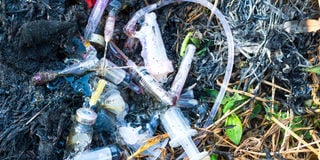The ugly side of Covid-19 mass vaccinations

Experts have warned about the indiscriminate disposal of solid waste coming from the mass vaccinations and the accompanying air pollution.
What you need to know:
- Experts have warned about the indiscriminate disposal of solid waste
- Millions of vials and syringes are thrown in the environment, triggering concerns
- While HFCs have been used in refrigeration, there are alternatives which vaccine manufacturers and transporters can adopt
A photo of scavengers donning hazmat suits at the Dandora dumpsite has attracted public fury, with concerns raised about the poor disposal of medical waste.
However, this could just be the tip of the iceberg as the Covid-19 pandemic management is expected to not only increase solid waste in the environment, but also contribute to climate change and air pollution.
From the production of hydrofluorocarbons (HFCs) - powerful greenhouse gases, and carbon dioxide during storage and transportation of Covid-19 vaccines, the impact of Covid-19 will be felt for long.
Experts have warned about the indiscriminate disposal of solid waste coming from the mass vaccinations and the accompanying air pollution.
Millions of vials and syringes are thrown in the environment, triggering concerns.
Food chain
“The effects of the pollution on the ecosystem go far and wide; from rain forests to the deepest ocean trenches and on our food chains when plastic waste is consumed by fish and livestock. From producers to consumers, we are all at risk and therefore must take a collective stance on a common solution,” said Josephine Wawira, a communications officer at Sustainable Inclusive Business.
But, it is not only solid waste which is worrying environmentalists, the Covid-19 vaccine rollout is proving to be a challenge.
While the vaccines are the lesser evil at the moment in terms of environmental waste, they have come with challenges.
An article published in the Journal of Climate Change and Health said millions of plastic syringes, needles and vials plus their packaging components may end up into the environment, an issue which needs to be handled before it gets out of hand, the experts argued.
Seemingly minimal, there is resultant air pollution from aerosols (like sanitisers) which could have ozone depleting substances, and gases produced during transportation of the vaccines cannot be ignored.
“We must know the components of these aerosols and understand the environmental implication. But at the moment we are concerned about ship and road transportation,” said a Unep official, who did not wish to be named as he is not authorised to speak to the press.
He added that while HFCs have been used in refrigeration, there are alternatives which vaccine manufacturers and transporters can adopt.
Greenhouse gases
This is because vaccines are stored in massive freezers and transported by air and on land posing not only health but also environmental problems.
But, these freezers use HFCs to keep the temperatures down. Unfortunately, these are more powerful greenhouses gases than carbon dioxide, and are able to stay in the atmosphere for between 15 and 29 years.
“A business-as-normal approach would see widespread use of polluting diesel generators to power fridges in places where electricity supply is fragile or non-existent.
“It could mean the use of climate warming refrigerants such as hydrofluorocarbons that can have a global warming potential hundreds or even thousands of times greater than carbon dioxide,” said Unep in a write up.
For example, the Pfizer-BioNTech vaccine requires refrigeration of -70°C and Moderna’s jab is stored at -20 °C, while the Oxford/AstraZeneca vaccine can transported and stored in the normal fridge temperatures.
According to Unep, “rolling out Covid-19 vaccines on a global scale will require an enormous expansion in capacity of the global cold chain”.
While Kenya is yet to acquire other vaccines than the AstraZeneca, the government did not rule them out.
As such, the UN body suggests to governments to “create a new cold chain for the Covid-19 vaccine, part of which at least could, once the current crisis has passed, be used to transport other goods, like agricultural produce.”



